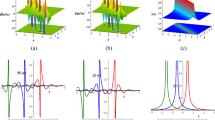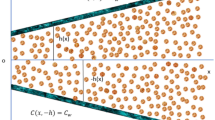Abstract
The two‐dimensional inviscid nonstationary flow behind a shock wave passing through solid uranium dioxide or carbide particles suspended in liquid iron was simulated numerically. Such layers can appear inside planets in the vicinity of the planet's solid core. Shock waves passing in the interior of a planet (resulting from a possible asteroid impact on the planet) can change parameters of the layer. The calculations demonstrated that the local particle massconcentration behind the incident and reflected shock waves increases considerably, which can cause a transition of the layer into a supercritical state and a nuclear explosion inside the planet. The problem was solved taking into account possible particle collisions and their deformation and fission as well as changes in the fields of major thermodynamic parameters inside and outside each particle.
Similar content being viewed by others
REFERENCES
V. F. Anisichkin, "Do planets burst?" Fiz. Goreniya Vzryva, 33, No. 1, 138-142 (1997).
V. A. Agureikin and B. P. Kryukov, "The method of individual particles for calculating uxes of multicomponent media with large deformations," in: Numerical Methods of Continuum Mechanics [in Russian], Inst. of Theor. and Appl. Mech., Sib. Div., Acad. of Sci. of the USSR, Vol. 17, No. 1 (1986), pp. 17-31.
A. I. Ivandaev and A. G. Kutushev, "Effect of dispersed particles on attenuation of blast waves in gas mixtures and their interaction with barriers," in: Non-Stationary Flows of Multiphase Systems with Physicochemical Conversions [in Russian], Izd. Mosk. Univ., Moscow (1983), pp. 60-79.
A. A. Zhilin and A. V. Fedotov, "Reection of shock waves from a rigid boundary in a mixture of condensed materials. I. Equilibrium approximation," Prikl. Mekh. Tekh. Fiz., 40, No. 5, 73-78 (1999).
V. N. Zharkov, Internal Structure of the Earth and Planets [in Russian], Nauka, Moscow (1983).
V. F. Anisichkin, "Shock-wave data as evidence of the presence of carbon in the Earth's core and lower mantle," Fiz. Goreniya Vzryva, 36, No. 4, 108-114 (2000).
Author information
Authors and Affiliations
Rights and permissions
About this article
Cite this article
Voronin, D.V., Anisichkin, V.F. Simulation of the Behavior of Mixtures of Heavy Particles Behind a Shock‐Wave Front. Combustion, Explosion, and Shock Waves 37, 470–474 (2001). https://doi.org/10.1023/A:1017965432562
Issue Date:
DOI: https://doi.org/10.1023/A:1017965432562




